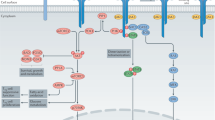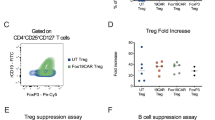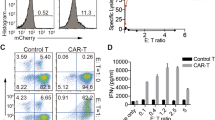Abstract
Systemic lupus erythematosus (SLE) is a potentially life-threatening autoimmune disease characterized by altered balance of activity between effector and regulatory CD4+ T cells. The homeostasis of CD4+ T cell subsets is regulated by interleukin (IL)-2, and reduced production of IL-2 by T cells is observed in individuals with SLE. Here we report that treatment with low-dose recombinant human IL-2 selectively modulated the abundance of regulatory T (Treg) cells, follicular helper T (TFH) cells and IL-17-producing helper T (TH17) cells, but not TH1 or TH2 cells, accompanied by marked reductions of disease activity in patients with SLE.
This is a preview of subscription content, access via your institution
Access options
Subscribe to this journal
Receive 12 print issues and online access
$209.00 per year
only $17.42 per issue
Buy this article
- Purchase on Springer Link
- Instant access to full article PDF
Prices may be subject to local taxes which are calculated during checkout


Similar content being viewed by others
References
Tsokos, G.C. N. Engl. J. Med. 365, 2110–2121 (2011).
Liu, Z. & Davidson, A. Nat. Med. 18, 871–882 (2012).
Crispín, J.C., Kyttaris, V.C., Terhorst, C. & Tsokos, G.C. Nat. Rev. Rheumatol. 6, 317–325 (2010).
He, J. et al. Immunity 39, 770–781 (2013).
Choi, J.Y. et al. Arthritis Rheumatol. 67, 988–999 (2015).
Vincent, F.B., Northcott, M., Hoi, A., Mackay, F. & Morand, E.F. Arthritis Res. Ther. 15, R97 (2013).
Yang, J. et al. Arthritis Rheum. 60, 1472–1483 (2009).
Shin, M.S., Lee, N. & Kang, I. Curr. Opin. Rheumatol. 23, 444–448 (2011).
Boyman, O. & Sprent, J. Nat. Rev. Immunol. 12, 180–190 (2012).
Laurence, A. et al. Immunity 26, 371–381 (2007).
Ballesteros-Tato, A. et al. Immunity 36, 847–856 (2012).
Castela, E. et al. JAMA Dermatol. 150, 748–751 (2014).
Hartemann, A. et al. Lancet Diabetes Endocrinol. 1, 295–305 (2013).
Koreth, J. et al. N. Engl. J. Med. 365, 2055–2066 (2011).
Klatzmann, D. & Abbas, A.K. Nat. Rev. Immunol. 15, 283–294 (2015).
Saadoun, D. et al. N. Engl. J. Med. 365, 2067–2077 (2011).
Humrich, J.Y. et al. Ann. Rheum. Dis. 74, 791–792 (2015).
Matsuoka, K. et al. Sci. Transl. Med. 5, 179ra43 (2013).
Lieberman, L.A. & Tsokos, G.C. J. Biomed. Biotechnol. 2010, 740619 (2010).
Crispín, J.C. et al. J. Immunol. 181, 8761–8766 (2008).
Hoes, J.N. et al. Ann. Rheum. Dis. 66, 1560–1567 (2007).
Hochberg, M.C. Arthritis Rheum. 40, 1725 (1997).
Petri, M. et al. N. Engl. J. Med. 353, 2550–2558 (2005).
Furie, R.A. et al. Arthritis Rheum. 61, 1143–1151 (2009).
Liu, W. et al. J. Exp. Med. 203, 1701–1711 (2006).
Seddiki, N. et al. J. Exp. Med. 203, 1693–1700 (2006).
Acosta-Rodriguez, E.V. et al. Nat. Immunol. 8, 639–646 (2007).
Acknowledgements
The work was supported by the National Sci-Tech Support Program (grant no. 2014BAI07B01; Z.L.), the National Basic Research Program of China 973 Program (grant no. 2014CB541903 (D.Y.), 2014CB541901 (N.S.) and 2010CB529104 (Z.L.)), the National Natural Science Foundation of China (NSFC) (grant no. 81373117 (J.H.), 31570880 (J.H.), 31530020 (Z.L.), 81429003 (D.Y.) and 81471601 (X.S.)), the Beijing Key Laboratory for Rheumatism and Immune Diagnosis (grant no. BZ0135; Z.L.), the Peking–Tsinghua Center for Life Sciences (Z.L.), the Priority Research Program of the Shandong Academy of Sciences (D.Y.), the Shandong Province Taishan Scholar Program (D.Y.) and the Australian National Health and Medical Research Council (NHMRC) Fellowship GNT1085509 (D.Y.).
Author information
Authors and Affiliations
Contributions
J.H. and Xia Zhang participated in literature searches, study design, patient recruitment, data collection, data analysis, data interpretation and writing of the paper; Y.W., X.S., X.H., Z.H. and Y.C. analyzed the biological data; R.J., C.X., L.Z., J.F., Y.A., C.L., X.L., H. Ye, Y. Jia, L.R., R.L., S.C., Xuewu Zhang, Y.S., Y. Jin, H. Yao and Y.L. participated in patient recruitment and data collection; J.D., Y.G. and Y.A.L. participated in animal experiments; J.G., N.S. and E.F.M. participated in data interpretation and in writing the report; Z.L. and D.Y. participated in study design, data interpretation and writing of the paper; and all authors contributed to the critical revision of the manuscript and approved the final version.
Corresponding authors
Ethics declarations
Competing interests
The authors declare no competing financial interests.
Supplementary information
Supplementary Text and Figures
Supplementary Tables 1–10 and Supplementary Figures 1–10 (PDF 2966 kb)
Rights and permissions
About this article
Cite this article
He, J., Zhang, X., Wei, Y. et al. Low-dose interleukin-2 treatment selectively modulates CD4+ T cell subsets in patients with systemic lupus erythematosus. Nat Med 22, 991–993 (2016). https://doi.org/10.1038/nm.4148
Received:
Accepted:
Published:
Issue Date:
DOI: https://doi.org/10.1038/nm.4148
This article is cited by
-
The effects of low-dose IL-2 on Th17/Treg cell imbalance in primary biliary cholangitis mouse models
BMC Gastroenterology (2024)
-
Efficacy, Safety and the Lymphocyte Subset Changes of Low-Dose IL-2 in Patients with Autoimmune Rheumatic Diseases: A Systematic Review and Meta-Analysis
Rheumatology and Therapy (2024)
-
Molecular Engineering of Interleukin-2 for Enhanced Therapeutic Activity in Autoimmune Diseases
BioDrugs (2024)
-
Elevated serum IL-2 and Th17/Treg imbalance are associated with gout
Clinical and Experimental Medicine (2024)
-
Regulatory T cells in autoimmune kidney diseases and transplantation
Nature Reviews Nephrology (2023)



